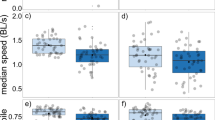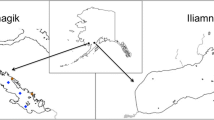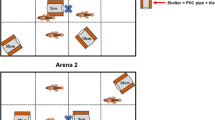Abstract
We compared the shoaling behaviour of three-spined sticklebacks, Gasterosteus aculeatus, infected with the microsporidian, Glugea anomala, to that of non-infected conspecifics. Infected fish lost significantly more weight than non-infected fish during a period of food deprivation, suggesting a metabolic cost to parasitism. In binary shoal choice tests, non-infected test fish showed an association preference for a shoal of non-infected over a shoal of infected conspecifics; infected test fish displayed no preference. Infected fish, however, showed a higher overall tendency to shoal than non-parasitised fish. Furthermore, infected fish occupied front positions within a mixed school. We consider the behavioural differences between infected and uninfected fish in the context of their potential benefits to the fish hosts and the parasites.
Similar content being viewed by others
References
R.D. Alexander (1974) ArticleTitleThe evolution of social behaviour Annu. Rev. Ecol. Systems 5 325–383
C. Arme R.W. Owen (1776) ArticleTitleInfections of the three-spined stickleback, Gasterosteus aculeatus L., with the plerocercoid larvae of Schistocephalus solidus Müller, 1776, with special reference to pathological effects Parasitology 57 301–314 Occurrence Handle10.1017/S0031182000072103
I. Barber (1997) ArticleTitleA non-invasive morphometric technique for estimating cestode plerocercoid burden in small freshwater fish J. Fish Biol. 51 654–658
I. Barber D. Hoare J. Krause (2000) ArticleTitleThe effects of parasites on fish behaviour: An evolutionary perspective and review Rev. Fish Biol. Fish. 10 1–35 Occurrence Handle10.1023/A:1008942318272
I. Barber F.A. Huntingford D.W.T. Crompton (1995) ArticleTitleThe effect of hunger and cestode parasitism on the shoaling decisions of small fresh-water fish J. Fish Biol. 47 524–536
C.R. Brown M.B. Brown (1986) ArticleTitleEctoparasitism as a cause of natal dispersal in cliff swallows Ecology 67 1206–1218
E.U. Canning (1977) Microsporidia J.P. Kreier (Eds) Parasitic Protozoa Academic Press New York 155–197
E.U. Canning J. Lom (1986) The Microsporidia of Vertebrates Academic Press London 23–42
I.M. Côté R. Poulin (1995) ArticleTitleParasitism and group-size in social animals–a meta-analysis Behav. Ecol. 6 159–165 Occurrence Handle10.1093/beheco/6.2.159
N. Giles (1983) ArticleTitleBehavioural effects of the parasite Schistocephalus solidus Cestoda on an intermediate host, the 3-spined stickleback, Gasterosteus aculeatus Anim. Behav. 31 1192–1194
E.M.A. Hensor J.-G.J. Godin D.J. Hoare J. Krause (2003) ArticleTitleEffects of nutritional state on the shoaling tendency of banded killifish, Fundulus diaphanus, in the field Anim. Behav. 65 663–669
J. Krause (1994) ArticleTitleDifferential fitness returns in relation to spatial positions in groups Biol. Rev. 69 187–206 Occurrence Handle1:STN:280:DyaK2czjtFGitA%3D%3D
J. Krause J.-G.J. Godin (1995) ArticleTitlePredator preference for attacking particular prey group sizes–consequences for predator hunting success and prey predation risk Anim. Behav. 50 465–473
J. Krause S.P. Loader J. McDermott G.D. Ruxton (1998) ArticleTitleRefuge use by fish as a function of body length-related metabolic expenditure and predation risks Proc. The Roy. Soc. London Series B 265 2373–2379
J. Krause G.D. Ruxton (2002) Living in Groups Oxford University Press Oxford, UK 6–40
M. Milinski (1984) ArticleTitleParasites determine a predator’s optima feeding strategy Behav. Ecol. Sociobiol. 15 35–37
M. Milinski (1985) ArticleTitleRisk of predation of parasitised sticklebacks Gasterosteus aculeatus L. under competition for food Behaviour 93 203–216
M. Milinski (1990) Parasite and host decision-making C.J. Barnard J.M. Behnke (Eds) Parasitism and Host Behaviour Taylor and Francis London, UK 95–116
R.E.L. Taylor M. Lott (1978) ArticleTitleTransmission of salmonid whirling disease by birds fed trout infected with Myxosoma cerebralis J. Protozool. 25 105–106 Occurrence Handle1:STN:280:DyaE1c7ps1Oksw%3D%3D
G.F. Turner T.J. Pitcher (1986) ArticleTitleAttack abatement: A model for group protection by combined avoidance and dilution Am. Natural. 128 228–240
M. Walkey R.H. Meakins (1970) ArticleTitleAn attempt to balance the energy budget of a host-parasite system J. Fish Biol. 2 361–372
A.J.W. Ward S. Axford J. Krause (2003) ArticleTitleCross-species familiarity in shoaling fishes Proc. Roy. Soc. London B 270 1157–1161 Occurrence Handle1:STN:280:DC%2BD3s3ovFOisw%3D%3D
A.J.W. Ward D.J. Hoare I.D. Couzin M. Broom J. Krause (2002) ArticleTitleThe effects of parasitism and body length on positioning within wild fish shoals J. Anim. Ecol. 71 10–14
A.J.W. Ward J. Krause (2001) ArticleTitleBody length assortative shoaling in the European minnow, Phoxinus phoxinus Anim. Behav. 62 617–621
Ward, A.J.W., P. Thomas, P.J.B. Hart & J. Krause. in press. Correlates of Boldness in Three-Spined Sticklebacks ( Gasterosteus aculeatus). Behav. Ecol. Sociobiol.
R. Weissenberg (1968) ArticleTitleIntracellular development of the microsporidian Glugea anomala Moniez in hypertrophying migratory cells of the fish Gasterosteus aculeatus L., an example of the formation of “xenoma” tumours J. Protozool. 15 44–57
Author information
Authors and Affiliations
Corresponding author
Rights and permissions
About this article
Cite this article
Ward, A.J.W., Duff, A.J., Krause, J. et al. Shoaling behaviour of sticklebacks infected with the microsporidian parasite, Glugea anomala . Environ Biol Fish 72, 155–160 (2005). https://doi.org/10.1007/s10641-004-9078-1
Received:
Accepted:
Issue Date:
DOI: https://doi.org/10.1007/s10641-004-9078-1




